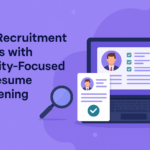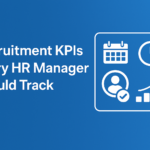The Best Fluffy Pancakes recipe you will fall in love with. Full of tips and tricks to help you make the best pancakes.
Finding Hidden Gems: How to Evaluate Resumes Beyond the Surface
Recruiting top talent is crucial for any company’s success. However, many great candidates might hide behind seemingly average resumes. These resumes often follow standard formats and might not immediately catch your eye. Learning how to look beyond the surface can help you discover hidden gems. This guide explores strategies for effective resume evaluation strategy and identifying top talent, even when it’s not obvious.
Understanding Average Resumes
Definition and Characteristics of Average Resumes
Average resumes are very common in job applications. They often use generic templates and lack a unique touch. These resumes usually list basic details like work history, education, and standard skills. While they might seem simple, they can belong to very talented people. Knowing how to spot these resumes is the first step. Look for common formatting mistakes or predictable language. Many job seekers submit plain resumes that don’t stand out. But these documents might hide highly skilled individuals ready for the right opportunity.
An average resume might not highlight key achievements well. Candidates sometimes don’t know how to show off their unique strengths effectively. This can make their best qualities hard to see at first. Still, these resumes can contain valuable information if you look closely. The real challenge is reading between the lines. Good talent spotting techniques help uncover amazing abilities hidden in plain text. Evaluating these resumes needs a careful eye and smart thinking.
Overcoming First Impressions and Adjusting Expectations
Relying only on first impressions can cause you to miss great hires. Recruiters might overlook overlooked candidate skills because of quick judgments. It is very important to look deeper into each application. A good resume evaluation strategy involves looking beyond the obvious facts. Finding qualified candidates means breaking past initial assumptions and biases.
Average resumes require a different approach. Recruiters should adjust their expectations and avoid making snap decisions. Identifying top talent takes patience and detailed analysis. Important candidate potential markers might not be clear right away. Spotting potential in applications requires a critical but open mind. Deep resume analysis depth helps reveal unconventional talent indicators. Using a solid talent identification framework is key. A common mistake is sticking too closely to checklists or ignoring potential shown in unusual ways.
Ignoring non-standard work experiences or unique career paths can mean missing valuable skills. Many candidates have interesting stories hidden in their resumes. Therefore, strong resume screening insights are vital. It’s about more than just scanning for keywords. True candidate diamond mining involves understanding each applicant’s unique background and story. Finding the right balance between structured checks and open-minded searching is essential to uncover those hidden gems.
Developing a Resume Evaluation Strategy
Key Elements of a Resume Evaluation Framework
A strong resume evaluation strategy starts with a clear plan or framework. You can identify top talent more efficiently by creating structured guidelines. This framework should cover several elements to ensure deep resume analysis depth. Key parts include methods for identifying top talent, techniques for spotting potential in applications, and understanding unconventional talent indicators. A complete framework helps in finding qualified candidates and ensures every resume gets a fair look.
Creating a checklist improves the efficiency of gaining resume screening insights. The checklist should focus on candidate potential markers, balancing technical abilities with soft skills. Make sure to include both hard skills (like coding or accounting) and soft skills (like communication or teamwork) in your framework. This approach helps you see the whole candidate and recognize overlooked candidate skills. Such careful candidate diamond mining helps find those hidden gems.
| Framework Element | Description | Benefit |
|---|---|---|
| Standardized Criteria | Define core skills and qualifications needed. | Ensures consistency in evaluation. |
| Potential Markers Checklist | List key indicators of future success (e.g., problem-solving examples, initiative). | Helps in spotting potential in applications early. |
| Contextual Analysis Guide | Prompts evaluators to consider background, industry shifts, and career paths. | Provides deeper resume analysis depth. |
| Bias Mitigation Steps | Include checks like blind screening (removing names/schools initially). | Reduces unconscious bias in selection. |
Balancing Skills and Context in Evaluation
Balancing technical skills with soft skills is very important. Technical skills often fill up resumes, but soft skills show how a candidate might fit and grow. Context matters a lot when looking at a candidate’s experiences. True resume analysis depth requires understanding the details of different backgrounds. Think about diverse educational paths and career journeys as possible signs of talent and resilience.
Structured evaluation helps reduce bias during resume screening. Using a consistent talent identification framework makes the process fair. A systematic approach takes away personal feelings. It allows for equal assessment across all applications. Spotting potential in applications involves noticing unconventional talent indicators. This makes your resume evaluation strategy more complete and fair.
Tools can greatly help streamline this process. For instance, CVShelf is an AI-powered recruitment platform built to make hiring easier. It automates CV screening using smart analysis. This helps recruiters quickly find top candidates by matching skills to job needs. CVShelf also generates smart job descriptions based on your company website. This ensures the descriptions match your company culture. Features like detailed candidate reports and automated emailing improve efficiency. Integration with platforms like BDJOBS further simplifies candidate outreach.
Techniques for Spotting Top Talent
Creative Talent Spotting Techniques
Identifying top talent requires more than just a standard resume evaluation strategy. The secret is using diverse talent spotting techniques. Look for unconventional talent indicators that often hide in plain view. Think about personal projects or volunteer work a candidate has done. These activities can reveal hidden gems missed by traditional methods. Such efforts show dedication, creativity, and problem-solving skills.
Look beyond the usual metrics found on resumes. Analyze the resume content deeply to find unique stories. Focus on candidate potential markers, like skills learned during personal projects or side hustles. These give a clearer view of an applicant’s ability to succeed. Spotting potential in applications includes assessing how candidates used their time, even during employment gaps. Did they learn a new skill or contribute to an open-source project?
Leveraging Unconventional Talent Indicators
Resilience and adaptability are vital traits when finding qualified candidates. Looking at employment gaps differently can be insightful. Instead of seeing gaps as negatives, view them as potential opportunities. They often show a candidate’s strength in overcoming challenges or taking calculated risks.
Evaluate these periods for any professional growth or new skills gained. This non-traditional approach often helps discover overlooked candidate skills. Good resume screening insights should focus on the journey, not just the job titles. This kind of talent identification framework helps find those candidate diamond mining opportunities. It allows recruiters to spot hidden potential in diverse groups of applicants.
| Standard Indicator | Unconventional Indicator | What it Might Reveal |
|---|---|---|
| Job Titles/Company Names | Personal Projects/Portfolio | Initiative, passion, practical skills |
| Years of Experience | Handling of Employment Gaps | Resilience, learning agility, adaptability |
| Formal Education/Degrees | Online Courses/Certifications/Self-Study | Proactiveness, specific interests, commitment to growth |
| Listed Skills (Keywords) | Contributions to Open Source/Communities | Collaboration, real-world application, expertise |
Candidate Diamond Mining: Finding Qualified Candidates
Understanding Candidate Diamond Mining
Candidate diamond mining means identifying top talent from a large pool of applicants, like finding diamonds in the rough. It needs a refined resume evaluation strategy. The main goal is to find overlooked candidate skills that could be very valuable. Spotting potential in applications involves recognizing unconventional talent indicators. This process is like searching for precious gems; valuable candidates are found through careful, detailed examination.
Strategies for effective candidate diamond mining include creating a strong talent identification framework. This requires a resume analysis depth that looks past surface achievements. By using smart resume screening insights, recruiters can better judge the true potential of each applicant. This method helps find candidates who might not seem impressive at first but have great potential.
Tools and Techniques for Deeper Insights
Finding qualified candidates often means digging deeper into their resumes and past experiences. Effective talent spotting techniques are crucial for this. Recruiters can improve their resume evaluation strategy by using technology and tools made for deeper analysis. Platforms like CVShelf use AI to analyze CVs and provide detailed candidate reports. This automation helps quickly sift through applications and highlight potential matches based on skills and experience, making the initial screening more efficient.
These tools help spot candidate potential markers that might be missed manually. Also, building a culture of curiosity in the hiring team is important. Asking thoughtful follow-up questions during interviews can uncover hidden strengths not obvious on paper. This approach ensures recruiters don’t miss candidates who could bring valuable skills and fresh perspectives. Using these strategies helps organizations find the hidden gems among seemingly average resumes. Learn more about evaluating resumes effectively in our FAQ section.
| Diamond Mining Strategy | Description | Tool/Technique Example |
|---|---|---|
| Look Beyond Keywords | Analyze context, achievements, and transferable skills. | AI Resume Analysis (e.g., CVShelf), Behavioral Questions |
| Assess Potential over Polish | Focus on growth trajectory, learning ability, and motivation. | Skills Assessments, Project Reviews |
| Investigate Gaps & Transitions | Ask questions about career breaks or shifts to understand context. | Structured Interviews, Reference Checks |
| Value Diverse Experiences | Recognize skills gained from non-traditional paths (volunteering, projects). | Holistic Review Framework, Portfolio Assessment |
Conclusion: Embracing Unique Profiles in Hiring
Recognizing the Value of Overlooked Candidates
Finding qualified candidates often means identifying top talent hiding beneath the surface. Many great individuals have overlooked candidate skills not easily seen at first glance. Spotting potential in applications needs a good understanding of unconventional talent indicators. By using a resume evaluation strategy that accepts these unique signs, recruiters can find hidden gems among piles of average resumes. The process might take effort, but the results are worth it. Candidates found this way bring diverse skills that can fuel innovation.
Recruiters should adopt a mindset that values different kinds of talent. Traditional talent spotting techniques should mix with newer methods to broaden the talent pool. This ensures recruiters don’t miss amazing candidates who might otherwise be overlooked. Embracing diverse skills and backgrounds makes teams stronger and better at solving problems. A talent identification framework that values this diversity can improve hiring and company culture.
Long-Term Benefits and Implementation Steps
Spending time on thorough resume analysis depth has lasting benefits. Recruiters get better resume screening insights into candidate potential markers by looking deeper. It helps them predict the future impact of unconventional applicants. The better the insights, the better the hiring decisions. This proactive approach builds a stronger, more adaptable workforce, helping the organization succeed long-term.
Mixing traditional evaluation with creative techniques is key for effective hiring. A good resume screening process should balance proven methods with new strategies for finding unique skills. Candidate diamond mining works best when supported by both reliable and fresh approaches. The next steps involve adding these strategies into your current hiring process. Training recruitment teams on these ideas ensures ongoing success in finding talent, leading to a future-ready workforce. The goal isn’t just filling jobs, but building a talent pool that thrives on diversity and new ideas. Consider exploring resources like SHRM for more insights on modern recruitment practices.
Frequently Asked Questions (FAQ)
- What is an average resume?
- An average resume typically follows generic templates. It contains basic information like work history, education, and standard skills. It often lacks unique flair. While simple, it might belong to a talented person.
- Why do average resumes often go unnoticed?
- Average resumes might fail to highlight key achievements or unique strengths well. This makes standout qualities hard to see at first. Many candidates don’t know how to showcase their talents effectively on paper.
- How can recruiters overcome first impressions when evaluating resumes?
- Recruiters should adjust expectations and avoid quick judgments. Relying only on first impressions leads to missed opportunities. It’s vital to look deeper into applications for a full analysis using a good resume evaluation strategy.
- What are the key elements of a resume evaluation framework?
- A solid resume evaluation framework should include ways for identifying top talent, spotting potential in applications, and understanding unconventional talent indicators. A checklist can help make evaluation consistent.
- Why is balancing technical and soft skills important in resume evaluation?
- Balancing technical skills with soft skills is vital because soft skills show a candidate’s potential fit and growth. Understanding the context of their experience reveals important details missed by just listing skills.
- What are creative talent spotting techniques?
- Creative talent spotting techniques mean looking beyond standard resume data. Explore personal projects, volunteer work, or online contributions. These can show initiative, passion, and practical skills often missed.
- How can unconventional talent indicators help in candidate evaluation?
- Unconventional talent indicators, like resilience shown during job gaps or skills from hobbies, reveal valuable traits. They show potential not visible through traditional checks, helping find overlooked candidate skills.
- What does candidate diamond mining entail?
- Candidate diamond mining is the process of identifying top talent from many applicants. It involves recognizing unconventional talent indicators and assessing potential beyond surface achievements through deep resume analysis depth.
- What tools and techniques can enhance resume evaluation?
- Technology like AI-powered platforms (e.g., CVShelf) can automate screening and provide deeper analysis. Also, fostering curiosity and asking probing questions during interviews helps uncover hidden potential.
- Why is it important to recognize overlooked candidates?
- Recognizing overlooked candidates lets recruiters find valuable skills that drive innovation. Understanding unconventional talent indicators helps uncover hidden gems among average resumes, leading to stronger teams.
- What are the long-term benefits of thorough resume analysis?
- Investing time in deep resume analysis depth gives richer resume screening insights into candidate potential markers. This leads to better hiring decisions and builds a more dynamic, successful workforce over time.
- How can organizations implement these resume evaluation strategies effectively?
- Organizations can add these strategies into their hiring process. Train recruitment teams to blend traditional evaluation with creative techniques. This ensures ongoing success in talent acquisition and builds a future-ready workforce.




